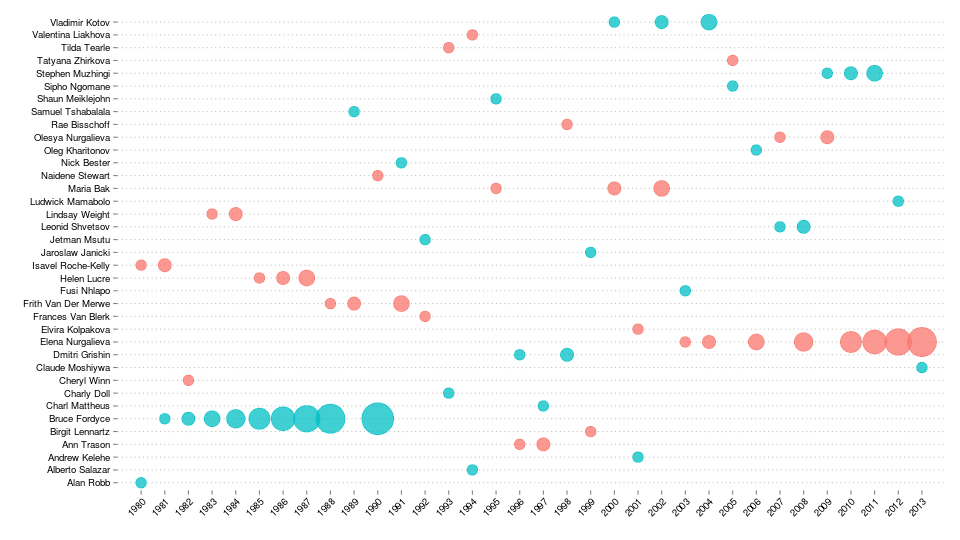Continuing on my quest to document the Comrades Marathon results, today I have put together a chart showing the winners of both the men and ladies races since 1980. Click on the image below to see a larger version.

The analysis started off with the same data set that I was working with before, from which I extracted only the records for the winners.
winners = subset(results, gender.position == 1, select = c(year, name, gender, race.time))
head(winners)
year name gender race.time
1 1980 Alan Robb Male 05:38:25
428 1980 Isavel Roche-Kelly Female 07:18:00
3981 1981 Bruce Fordyce Male 05:37:28
4055 1981 Isavel Roche-Kelly Female 06:44:35
7643 1982 Bruce Fordyce Male 05:34:22
7873 1982 Cheryl Winn Female 07:04:59
I then added in a field which gives a count of the number of times each person won the race.
library(plyr)
winners = ddply(winners, .(name), function(df) {
df = df[order(df$year),]
df$count = 1:nrow(df)
return(df)
})
subset(winners, name == "Bruce Fordyce")
year name gender race.time count
7 1981 Bruce Fordyce Male 05:37:28 1
8 1982 Bruce Fordyce Male 05:34:22 2
9 1983 Bruce Fordyce Male 05:30:12 3
10 1984 Bruce Fordyce Male 05:27:18 4
11 1985 Bruce Fordyce Male 05:37:01 5
12 1986 Bruce Fordyce Male 05:24:07 6
13 1987 Bruce Fordyce Male 05:37:01 7
14 1988 Bruce Fordyce Male 05:27:42 8
15 1990 Bruce Fordyce Male 05:40:25 9
The chart was generated as a scatter plot using ggplot2. The size of the points relates to the number of times each person won the race. The colour scale is as you might imagine: pink for the ladies and blue for the men.
library(ggplot2)
ggplot(winners, aes(x = year, y = name, color = gender)) +
geom_point(aes(size = count), shape = 19, alpha = 0.75) +
scale_size_continuous(range = c(5, 15)) +
ylab("") + xlab("") +
scale_x_discrete(expand = c(0, 1)) +
theme(
axis.text.x = element_text(angle = 45, hjust = 1, colour = "black"),
axis.text.y = element_text(colour = "black"),
legend.position = "none",
panel.background = element_blank(),
panel.grid.major = element_line(linetype = "dotted", colour = "grey"),
panel.grid.major.x = element_blank()
)
Two of the key aspects of getting this to look just right were:
- the call to
scale_size_continuous()which ensured that a reasonable range of point sizes was used and - the call to
scale_x_discrete()which expanded the plot very slightly so that the points near the borders were not cropped.